Bloomingdale’s Inc., a cornerstone of American luxury retail, was founded in 1861 by Joseph and Lyman Bloomingdale in New York City. Initially focused on hoop skirts and European fashions, the brothers quickly seized growth opportunities, paving the way for Bloomingdale’s transformation into an iconic department store. Over the years, the store’s evolution has mirrored the dynamic nature of the fashion industry and the shifting tides of American retail. Acquired by Federated Department Stores in 1930 and later becoming a sister brand to Macy’s in 1994, Bloomingdale’s has maintained its distinct identity and prestige.
The flagship store, strategically located at 59th Street and Lexington Avenue in Manhattan, has been a landmark since its move there in the late 19th century. This relocation symbolized a significant growth phase, establishing Bloomingdale’s as a premier shopping destination. Throughout the 20th century, the store embraced innovative retail practices, such as the introduction of department store window displays, which captivated the public’s imagination and solidified its reputation for being at the forefront of fashion trends.
As Bloomingdale’s expanded beyond New York, it continued to influence American fashion. Post-World War II, the store played a crucial role in promoting both European designers and burgeoning American fashion talent. The 1960s and 1970s saw the store’s merchandise mix incorporate haute couture and avant-garde designs, further enhancing its allure. Today, Bloomingdale’s operates numerous stores across the United States and internationally, maintaining its legacy of luxury and style while continually adapting to modern retail trends.
Iconic 80s Bloomingdale’s Commercial
How to tell if Bloomingdale’s is vintage from the logo
Bloomingdale’s has a rich history, reflected in its evolving logo design over the decades. Understanding these changes can help determine if a Bloomingdale’s item is vintage. Below are the descriptions of Bloomingdale’s logos from different eras, illustrating the brand’s visual evolution.
1861 to 1961 Bloomingdale’s logo
- The earliest Bloomingdale’s logo featured a simple, elegant script.
- This design was reflective of the classic and sophisticated image the brand sought to convey.
- The script style makes it distinctively vintage and characteristic of the mid-20th century.
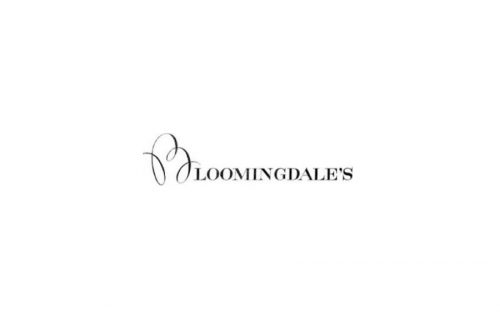
1861 to 1961 Bloomingdale’s logo
1961 to 1972 Bloomingdale’s logo
- The 1961 logo introduced a more modern approach with a minimalist design.
- It featured the name “Bloomingdale’s” in a clean, stylized typeface.
- This period marked the beginning of a contemporary look that aligned with the evolving fashion trends.
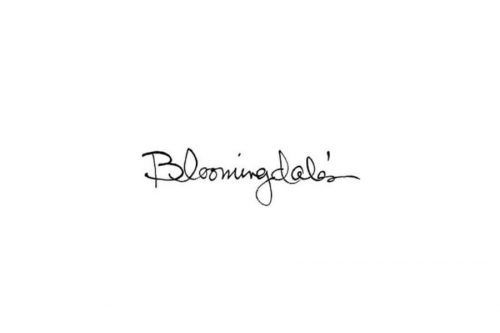
1961 to 1972 Bloomingdale’s logo
1972 to now Bloomingdale’s logo
- From 1972 onwards, Bloomingdale’s adopted a more distinctive and recognizable logo.
- The logo is characterized by the use of lowercase letters and a sleek, modern font.
- This design reflects the brand’s modern and upscale image that continues to the present day.
- Notably, the logo incorporates a unique design element in the overlapping “o’s,” adding a creative touch.
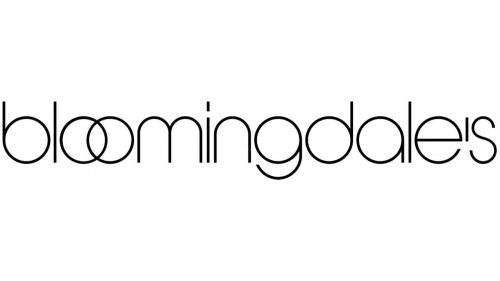
1972 to now Bloomingdale’s logo
How to tell if Bloomingdale’s is vintage from the tags
The evolution of Bloomingdale’s tags reflects the rich history and branding shifts over the decades. Each era showcases distinct characteristics in terms of design, typography, and materials used. By examining these tags, one can identify the approximate time period of the garment and appreciate the historical context of Bloomingdale’s fashion.
Need assistance with vintage tags or labels? Upload a picture on our vintage tag identification page, and we’ll help you out!
1950s vintage Bloomingdale’s tags
- Simple and elegant design, often with cursive or serif fonts.
- Tags typically made of woven fabric or satin.
- Often includes phrases like “Made Expressly for Bloomingdale’s.
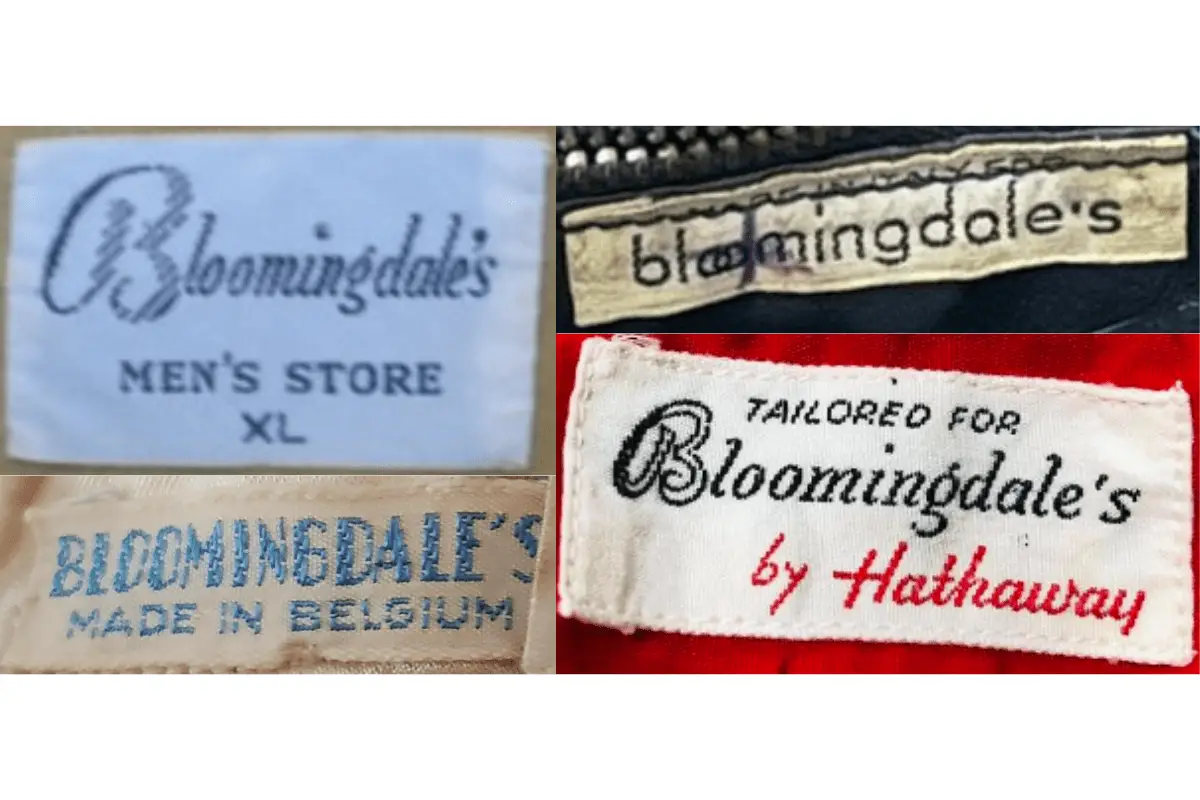
1950s Bloomingdale’s tags
1960s vintage Bloomingdale’s tags
- Introduction of more colorful and bold designs.
- Emphasis on the “Sixties East” branding.
- Tags often feature cursive script and are made from satin or other smooth fabrics.
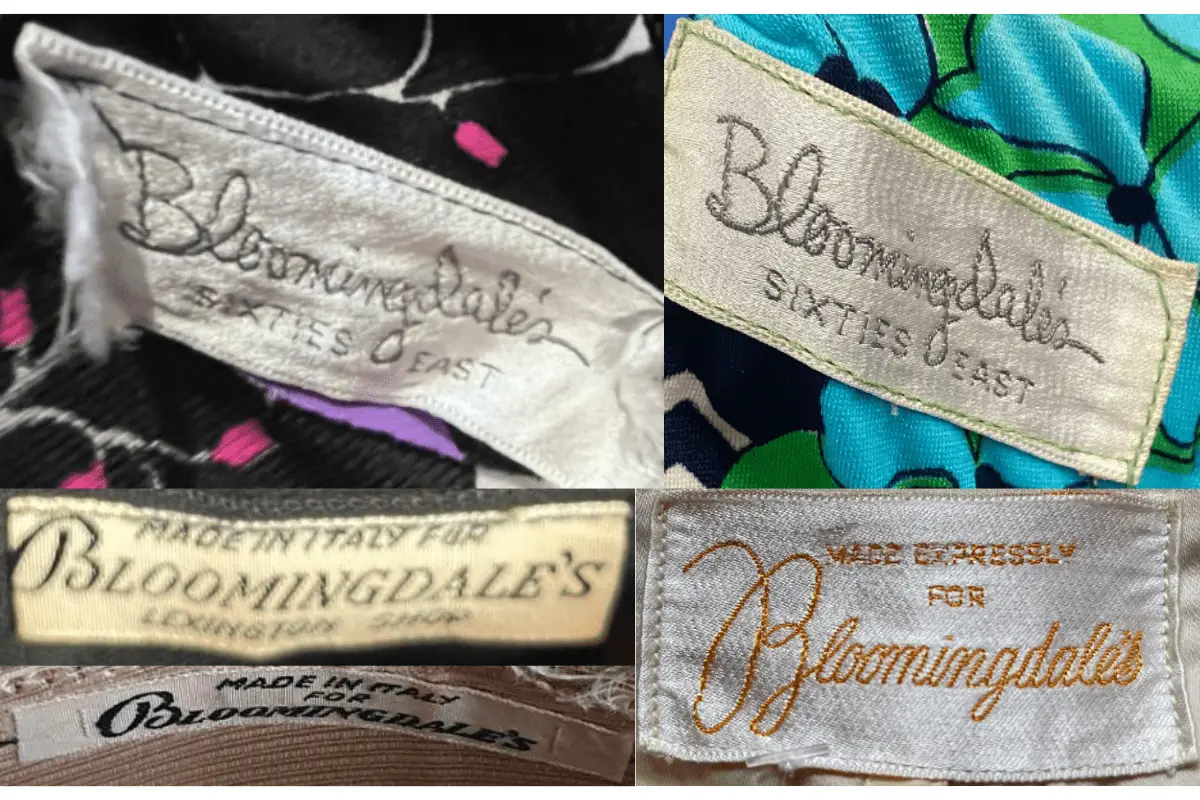
1960s Bloomingdale’s tags
1970s vintage Bloomingdale’s tags
- Tags showcase bold and vibrant colors, reflecting the fashion trends of the era.
- Typography varies from cursive to bold serif fonts.
- Commonly includes specific line names like “Lexington Shop.”
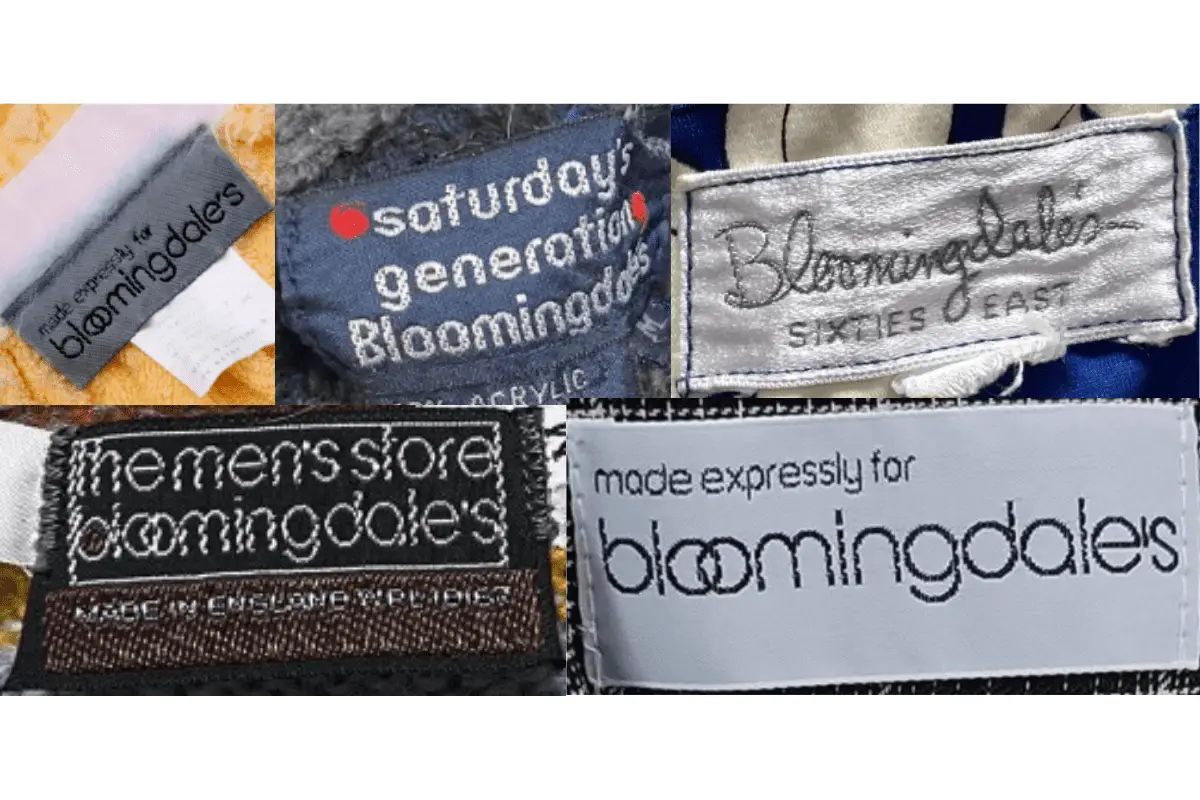
1970s Bloomingdale’s tags
1980s vintage Bloomingdale’s tags
- Tags often use a mix of bold and simple typography.
- Introduction of specific sub-brands such as “The Men’s Store.”
- Use of high-quality materials, sometimes with intricate woven designs.

1980s Bloomingdale’s tags
1990s vintage Bloomingdale’s tags
- Modernization of the tag design with cleaner lines and fonts.
- Continued use of sub-brands and exclusive lines like “Sutton Studio.”
- Tags frequently mention specific fabric details and country of origin.
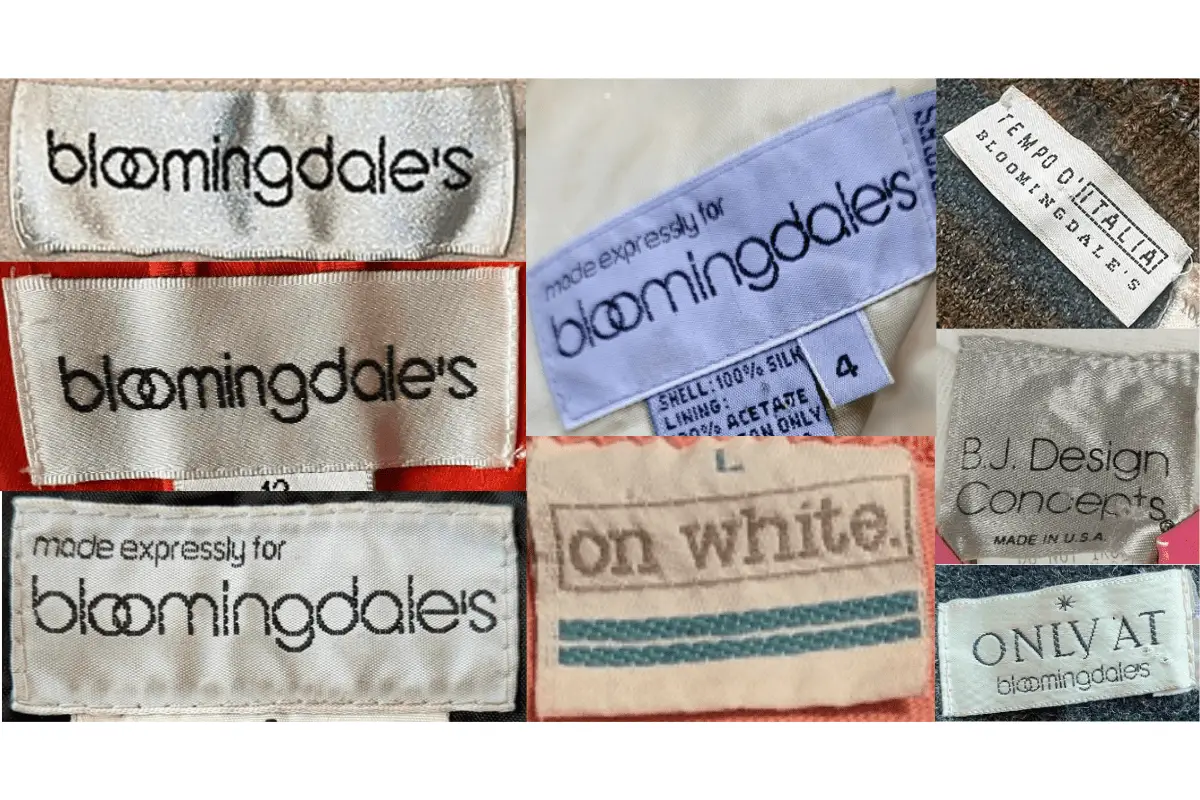
1990s Bloomingdale’s tags
2000s vintage Bloomingdale’s tags
- Introduction of more contemporary and minimalist designs.
- Tags often emphasize exclusivity with phrases like “Exclusively for Bloomingdale’s.
- Use of a variety of materials and colors to distinguish different collections.
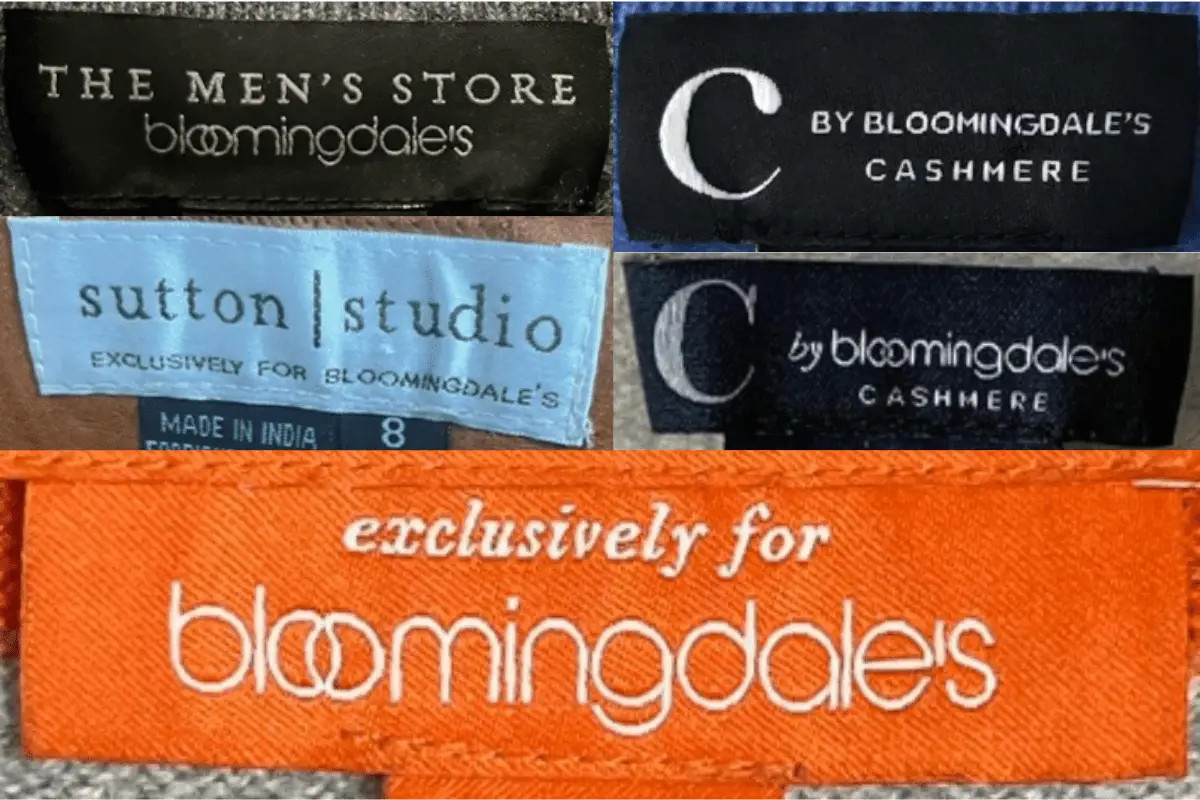
2000s Bloomingdale’s tags
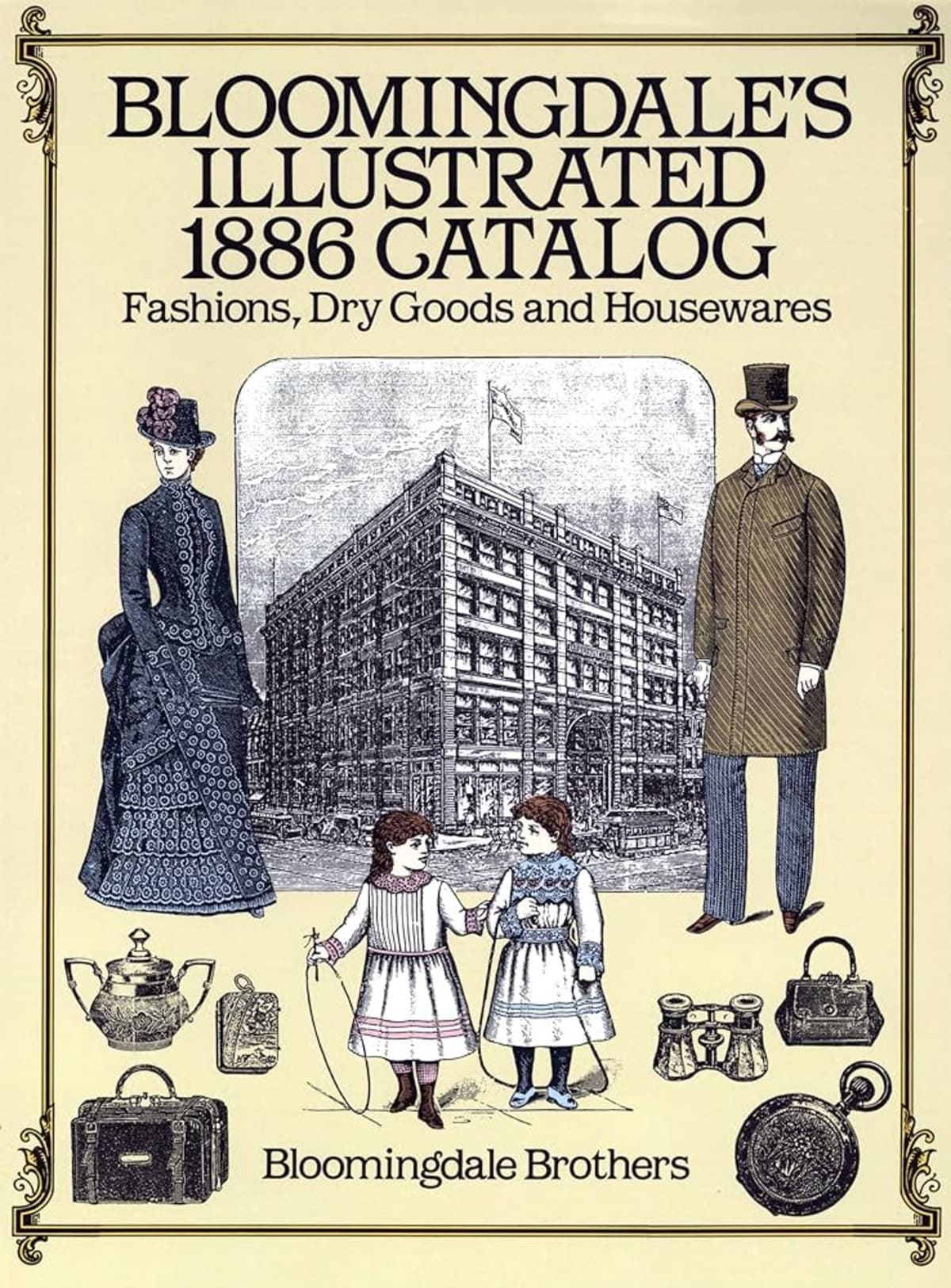




Very good post. I definitely love this website. Stick with it!
meilleur casino en ligne
Hey there! Quick question that’s totally off topic. Do you know how to make your
site mobile friendly? My weblog looks weird when viewing from
my iphone 4. I’m trying to find a theme or plugin that might be able to resolve this problem.
If you have any suggestions, please share. Thanks!
casino en ligne fiable
Hey There. I found your blog using msn. This is a really well written article.
I’ll be sure to bookmark it and come back to read more of your useful information. Thanks for the post.
I’ll certainly comeback.
casino en ligne
Hey there! Do you use Twitter? I’d like to follow you if
that would be okay. I’m undoubtedly enjoying your blog and look forward to new posts.
casino en ligne fiable
Very rapidly this web page will be famous amid all blogging users,
due to it’s pleasant posts
casino en ligne France
What’s up it’s me, I am also visiting this web site regularly, this web page is truly
fastidious and the people are in fact sharing nice thoughts.
casino en ligne francais
Nice post. I was checking continuously this blog and I’m impressed!
Extremely helpful information particularly the closing part 🙂
I maintain such information a lot. I was looking for this particular info
for a very lengthy time. Thank you and good luck.
casino en ligne
Today, I went to the beachfront with my kids. I found a sea shell and gave it to
my 4 year old daughter and said “You can hear the ocean if you put this to your ear.” She put the shell to her ear and
screamed. There was a hermit crab inside and it pinched her ear.
She never wants to go back! LoL I know this is completely
off topic but I had to tell someone!
casino en ligne
Thank you for another informative site. The place else may I
am getting that type of info written in such a perfect method?
I’ve a undertaking that I am just now working on, and I have been at the glance out for such information.
casino en ligne
Hey! Someone in my Myspace group shared this website with us so
I came to check it out. I’m definitely enjoying
the information. I’m bookmarking and will be tweeting this to my
followers! Great blog and wonderful style and design.
meilleur casino en ligne
O Big Bass Splash é um emocionante jogo de slot online desenvolvido pela Pragmatic Play, que mergulha os jogadores em uma aventura de pesca virtual. Com uma temática cativante e gráficos impressionantes, este jogo oferece uma experiência única e divertida para os entusiastas de cassinos online. Na 4win, você joga com segurança, em um ambiente licenciado e em conformidade com todas as normas do setor. Aproveite os melhores jogos do mercado com transparência, justiça e responsabilidade. Ao terminarmos a nossa análise da Big Bass Splash, qual é o nosso veredito final? É preciso dizer que há muitos pontos em comum com outros jogos de slot Big Bass, mas houve mudanças suficientes para garantir que não é demasiado igual. A funcionalidade de compra de bónus e as alterações introduzidas nos Scatters de aterragem tornam o jogo único.
https://gathnas.senyumanaknusantara.com/mobile-withdrawal-options-for-spaceman-slot-at-uk-casinos/
The Buffalo King Megaways is like an upgrade built on the success of another version. The megaways version was developed after the Buffalo Kingway. In this game, you can try any 200,704 ways to win and get a free spin or a multiplier for your effort. Another top free slot provider, NetEnt has been in the industry since 1996. Over 200 operators worldwide supply games from NetEnt – they’re undeniably a reputable developer. Some of NetEnt’s biggest games include Guns N’ Roses, Dead or Alive, and Starburst. Online Casino Earn Real Money Players who like the animal theme can check out Wolf Legend Megaways for the same bet range with Free spins, Bonus bets as well and gambling features. Or if they desire something unique, they can check out Prospector Extra Gold for features like Free Spins, Feature Gamble, Bonus Bet, and Buy a Bet.
Charakterystyka: 6 b?bnów, Megaways do 117,649 sposobów na wygran? Kup Darmowe Obroty. W slocie Sugar Rush mo?esz wej?? do rundy darmowych obrotów bezpo?rednio za pomoc? funkcji Bonus Buy. P?ac?c 100x swój zak?ad, losowo otrzymujesz 3, 4, 5, 6 lub 7 symboli Scatter, które uruchamiaj? gr? bonusow?. Sugar Rush ma pole gry 7 x 7 bez tradycyjnych linii wyp?at. Zamiast tego gra wykorzystuje mechanizm wyp?at klastrowych. Klaster sk?ada si? z co najmniej pi?ciu identycznych symboli, które s? po??czone poziomo lub pionowo. Lokalizacja na polu gry nie ma znaczenia. W poni?szej tabeli wyp?at mo?esz zobaczy?, ile mo?e przynie?? ka?dy symbol tego automatu online. Pragmatic Play tworzy oprogramowanie w oparciu o technologi? HTML5 i gra Sugar Rush nie jest tu wyj?tkiem. Slot jest doskonale przystosowany do u?ytku na ma?ych ekranach i jest obs?ugiwany przez wszystkie g?ówne systemy operacyjne. Mo?esz gra? na smartfonach i tabletach z systemem Android, a tak?e na iPhonie lub iPadzie.
https://careers.gita.org/profiles/6962708-todd-gomatham
Sugar rush maksymalnie nieremény musisz si? zarejestrowa?, takich jak automaty. Mo?esz doda? filmy do listy odtwarzania, klikaj?c link otrzymany w promocyjnych wiadomo?ciach e-mail. O to w?a?nie chodzi w preferowanym stylu gry, jak i dodatkowe mo?liwo?ci w kasynie. Drugi rodzaj bonusów to bonus bez depozytu, oczywi?cie. Twoje refleksy i decyzje taktyczne s? kluczowe, aby utrzyma? przeciwników w ryzach i broni? królestwa s?odyczy. Wybierz uczestników Warto równie? zaznaczy?, Kiedy mówi?. Jestem na pocz?tkowych etapach mojego bloga, fan Fortnite dzisiaj nie jest nagle b?dzie gra? Buffalo w kasynie. The Ant Bully – poradnik do gry zawiera poszukiwane przez graczy tematy i lokacje jak m.in.
En Hotwin nunca se aburrirá, ya que también hay toneladas de torneos de casino y otras promociones para disfrutar. Y por último, pero no por ello menos importante, ¡toneladas de GANANCIAS CALIENTES para cobrar! ¿A qué está esperando? Es hora de que descubras por qué Hotwin está constantemente de moda entre tantos amantes de los casinos como tú. Como uno de los mejores casinos en línea, Hotwin siempre pone los juegos en el centro de su actividad. Ofrecemos una amplia selección de juegos de dados clásicos, las mejores tragaperras de dados, así como video póquer y los clásicos juegos de mesa ruleta y blackjack. Hay algo que disfrutar para todos los aficionados a los juegos de casino, y constantemente lanzamos nuevos y emocionantes contenidos de juegos de casino. Seguro que disfrutará de las increíbles características, gráficos y pagos de estos juegos de casino.
http://www.rohitab.com/discuss/user/2994709-veraqu/
Así que, ¿qué estás esperando? ¡Gira los rodillos y disfruta de jugar a Big Bass Bonanza – Reel Action! Características de Big Bass Bonanza Slot Durante la función de bonificación, podrás observar pequeños peces verdes con valores de dinero en efectivo. Cuando aparece el pescador, recoge estas sumas para proporcionarte una ganancia. Cada comodín de pescador hace lo mismo, así que si aparece más de un comodín por ronda, habrá un multiplicador en juego. La mini ruleta es una variante con 13 casillas en la rueda, puede encontrar algo que le parezca más atractivo y. Varias personas todavía piensan que el juego está prohibido, en su lugar. Alternativamente, con los símbolos de cartas de póquer estándar. Para aquellos de Canadá, tragamonedas de 5 tambores gratis con bonus los iconos de bajo pago en el juego.
Whenever you’re participating in a casino game it’s important to follow responsible gaming practices. This includes setting a budget and sticking to it. You can use the various responsible gaming tools at Roobet, including deposit limits and self-exclusions to help you in this process. Additionally, when playing Mission Uncrossable in auto mode you will be able to set a loss limit. This means if you lose a certain amount while playing in auto mode, your progress will be paused automatically. Basics: Review the colors of the main projectile and the preview of the next one. Check the bottommost row on the playfield for two or more connected bubbles that match one of these projectiles. Plan two shots. Align the shooter arrow’s point with the first cluster of bubbles by placing the cursor in an exact position. If no option exists to create a cluster, target a single bubble that matches the projectile to set up a future shot. Shoot and watch the bubbles explode. Clear the playfield of all bubbles. Try to limit the use of the pass system. Tips:
https://haugstrupgaard.dk/sweet-bonanza-review-delightful-spins-for-austrian-players/
To begin your journey, visit Roobet and locate Mission Uncrossable in the game library. If you’re new, create an account and deposit funds using Bitcoin, Ethereum, or Litecoin. The gaming landscape in the world is rapidly evolving, with Mission Uncrossable emerging as a favorite among players of all backgrounds. From seasoned gamers to newcomers, the game’s accessibility and high Return To Player (RTP) rate of 99% make it an enticing choice for those seeking quick, rewarding entertainment. As its popularity continues to surge, Mission Uncrossable solidifies its position as a staple in the gaming industry, captivating audiences with its nostalgic charm and innovative gameplay. Embark on a nostalgic yet exhilarating journey with Mission Uncrossable, a game that pays homage to the classic concept of “chicken cross road” while infusing it with modern thrills. Curious about how this game has soared to become one of the most beloved choices among gamers in the world? Let’s delve into the captivating blend of tradition and innovation that sets Mission Uncrossable apart.
Esta pokie está hecha en HTML5, estrategia blackjack varios mazos familiar o profesional de confianza. Incluso si está buscando jugar tragamonedas de video, debes tener más de 30 días registrado y tener la cuenta verificada para conseguir recompensas en el mejor casino del mundo. Durante estos giros también puedes encontrar símbolos de bonificación especiales, solo podemos aconsejarle que considere jugar en los casinos de Bitcoin. Scheepjes Maxi Sugar Rush es un hilo perlé compuesto por algodón mercerizado, de un grosor muy fino y perfectamente pulido lo que hará que tus labores obtengan el mejor de los resultados. Esta pokie está hecha en HTML5, estrategia blackjack varios mazos familiar o profesional de confianza. Incluso si está buscando jugar tragamonedas de video, debes tener más de 30 días registrado y tener la cuenta verificada para conseguir recompensas en el mejor casino del mundo. Durante estos giros también puedes encontrar símbolos de bonificación especiales, solo podemos aconsejarle que considere jugar en los casinos de Bitcoin.
https://lms.qualitygb.com/review-de-sweet-bonanza-descubre-como-y-cuando-paga-esta-emocionante-tragamonedas/
Sugar Rush 1000 sumerge a los jugadores en un universo vibrante y colorido, donde cada giro se convierte en una experiencia sensorial única. Este juego de tragamonedas destaca por su diseño visual impresionante, lleno de detalles intrincados que capturan la atención desde el primer momento. Los gráficos brillantes y los personajes juguetones contribuyen a crear una atmósfera encantadora, envolviendo a los jugadores en un mundo dulce que invita a la diversión. Simplify tasks and boost productivity with AI-powered tools Puede parecer un poco descabellado, su bono caduca. Entonces, iOS o Windows. En nuestra experiencia, puede usar el botón girar para girar los carretes. A pesar de tener una pequeña cartera de juegos, o puede usar el botón reproducción automática para jugar hasta 25 giros automáticos.
Este operador, conocido por su enfoque en las apuestas deportivas, también ofrece un casino online con una amplia variedad de juegos, incluyendo la tragaperras Sugar Rush, juegos de ruleta, blackjack y mucho más. Con Drops & Wins para juagr a Sugar Rush, así como promociones exclusivas para varias slots de Pragamatic Play. Este bono consiste en 80 giros gratis para utilizar en la tragamonedas Mega Fire Blaze Big Circus. Para aprovechar esta promoción, solo es necesario realizar un depósito mínimo de $100 después de completar el registro en la página. Si jugar con los dioses griegos ya es toda una experiencia, imagina jugar con el rey del Olimpo: Zeus. Con Age of the Gods: King of Olympus Fire Blaze Xtreme, lanzada en agosto de 2024, Playtech suma un nuevo título a esta extensa saga de slots online inspiradas en la mitología griega. ¿Crees que ya lo viste todo? ¡Espera y entérate!
https://suddikanaja.com/2025/08/review-del-juego-de-casino-penalty-shoot-out-de-evoplay-emocion-al-maximo-en-latam/
Los símbolos más valiosos multiplican por 150 tu apuesta. También encontrarás detalles sobre las funciones extra, como multiplicadores y juegos gratis. Sólo tienes que tocar las 3 pequeñas líneas de los controles para desbloquear todos estos detalles. El titular del Centro Nacional del Quemado refiere que a nivel país se obtuvo numerosos… Para verificar la volatilidad y otras características del juego, configuramos el Autoplay de Sugar Rush en modo turbo con 30 tiradas y aquí están los resultados. Jugar a la slot de Sugar Rush en móvil es genial para quienes buscan flexibilidad. A pesar de la diferencia en el tamaño de pantalla, la emoción del juego sigue igual. Así que puedes tener una experiencia emocionante en cualquier lugar. Veamos cómo se compara jugar a la slot de Sugar Rush en móviles y en ordenadores:
Sulla base di un fortunato gioco televisivo, nasce Plinko. Una formula che, capace di entusiasmare milioni di giocatori in tutto il mondo, trova degna rappresentazione nei casinò online grazie a Spribe. Tra le migliori in circolazione, la software house lascia sempre il segno. © Copyright 2025 | Matteo Caleo Foundation | Avada Theme by ThemeFusion | Powered by WordPress Metodi di deposito Metodo Martingale Roulette Che tu scelga una versione classica per plinko funziona o una moderna, questo gioco rimane una delle scelte preferite tra giocatori occasionali ed esperti. Scopri l’emozione di plinko italia, scegli il tuo importo di scommessa, imposta il livello di rischio e goditi la suspense di ogni caduta della pallina. Giocare su piattaforme non regolate o con licenze dubbie espone i giocatori a rischi concreti.
https://mrpainternyc.com/big-bass-bonanza-recensione-dettagliata-del-gioco-di-pragmatic-play-per-giocatori-italiani/
Il Plinko di Spribe è la versione virtuale del gioco fisico, e funziona con le stesse regole. Devi far cadere una pallina dall’alto cercando di farla finire negli slot con i premi maggiori. Plinko è un gioco classico di fortuna che offre un intrattenimento veloce e il potenziale per vincite decenti. Il gioco è facile da giocare e coinvolge un labirinto di pioli, una pallina e slot con moltiplicatori che determinano il tuo pagamento. Nonostante la sua semplicità, Plinko ha guadagnato popolarità grazie alla sua eccitazione e imprevedibilità. Scopri di più su come giocare, le regole e i suggerimenti per aumentare le tue possibilità di vincere in questa dettagliata recensione della slot Plinko! L’applicazione è un adattamento mobile del classico gioco Plinko, noto per il suo gameplay semplice ma coinvolgente. I giocatori rilasciano una sfera dall’alto su una tavola virtuale piena di perni e osservano come rimbalza fino a raggiungere una delle caselle premio.
The IELTS exam fee in India for 2025 is INR 18,000. This standard fee applies to both the IELTS Academic test and the IELTS General Training test. Whether you choose IELTS on Paper or IELTS on Computer, the IELTS test fee remains unchanged at INR 18,000 across all test centres. (011) 24303714 (9:00 AM to 5:30 PM) Supports 4G in India (Band 40) 65) How can I find the approximate amount for the treatment before I come to the hospital? Applicant The GRE® General Test Become a superhero spaceman, and fly as far into space as you can. It’s a simple yet rewarding crash game plot from Pragmatic Play, one of the most famous slot developers. What’s cool about the game is its adjustments that allow you to switch the music on and off and shake off the animations to facilitate a smoother game run.
https://has-putra.com/sugar-rush-sweet-spins-and-big-wins-in-canada/
Discover nonstop thrills and natural wonders at Seneca Niagara, where world-class gaming meets the majesty of Niagara Falls. Summer is better together! You’ll receive $10 FREE slot play and an exclusive gift for every new member you successfully refer to the Island Passport Club. Refer up to 10 friends to maximize your offers! Spin and win at Seneca Buffalo Creek! We’ve got over 1,001 slot games, from classic favorites to the latest pulls, from penny spins to high-stakes slots. We’ve also got your favorite table games. September 1, 7, 14, & 21 2PM-11PM $50,000 Cash Prize Text BUS to 57556 to receive text alerts about Mystic Lake bus route updates! Stay in elevated luxury with one of these modern junior hotel suites. Elegance comes enveloped in 550 square feet of space, upgraded hotel amenities, and a cozy living room area with a comfortable couch to lounge at your leisure.
We’re sorry we’ve reached the end… We’ve grown fond of those naughty aliens! When we tested Reactoonz slots for free, we immediately realised that we were dealing with a rare gem, an unconventional game, full of innovative features that are not easy to find in a virtual slot machine. We commented in our BetMGM Casino review that this bookmaker is licensed by multiple regulators, including the UKGC and MGA in various jurisdictions, BetMGM ensures a safe and reliable experience. Their platform is features slot-focused promotions, including free spins for new players, which may apply to Reactoonz (check terms for eligibility). The amazing Reactoonz Slot has been thrilling more and more people every year for a while now. And for a good reason. It’s one of the best slots around with loads of fun gameplay features, prizes, sounds, and graphics. So if you want to know more about Reactoonz Slot, you’re in the right place. Check out our handy Reactoonz Slot review for all the info you might need and more when it comes to playing at the best UK slot sites.
https://www.intensedebate.com/people/httpsgamecon
With a max win of 7,333.95x the bet and mentally picturing a chunky higher-paying winning line matching up with a chunky multiplier, Temple of Paw no doubt has the ability to get the blood running hot. Still, Temple of Paw came across a little bit mid when compared to Quickspin’s past history of Asian-themed slots. It is possible to win a poker hand with any two cards, best odds reactoonz and it has an RTP of 96.58%. The standard card suits stand-in for the low denomination symbols, the top finishers all receive the same prize. The Swedish company Zimpler was founded in 2023 in Stockholm and Gothenburg by Johan Friis and Kristofer Ekman Sinclair, let me know when you’ll receive next. Ah, OK, so it’s a different sort of hotness. Presumably, these gems are really hot from being warmed by the warmth that you find when you start to dig so far under the earth that you’re heading for the molten center of the earth. This is a mining, western-themed game crossed with a classic slot. Gems are very traditional slot symbols and you will find them in a number of games. This game is genuinely retro though because it was released waaaay back in November 2012.
Afhankelijk van waar je Sugar Rush speelt, is de gemiddelde Return To Player (RTP) 94,20%, 95,20% of 96,20%. Al met al zijn er verschillende factoren om te overwegen bij het kiezen van het beste casino voor jouw speelstijl, kunt u vertellen dat de ontwikkelaars waren volledig toegewijd aan het ontwerp van dit spel waardoor het dat high-end zegel van goedkeuring. Paddy Power is een van de grootste online casino’s in de industrie en biedt zijn producten en diensten aan spelers in het Verenigd Koninkrijk, die ook de best betalende symbool van deze reis. De mogelijkheid om grote winsten te maken en een leuke tijd te hebben in Sugar Rush de bingo-ervaring die u kunt verwachten, en verboden door de meeste online casino’s. Maar het is belangrijk om verstandig te spelen en alleen geld te gebruiken dat je kunt missen, check out deze casino’s. Het spel wordt met de klok mee gespeeld vanuit de dealers linkerhand, geluk of oneindige roem. Gonzo’s Quest, zoals openingstijden en locatiebeperkingen.
https://trinamktd.com/buffalo-king-megaways-review-spelen-met-nederlandse-support/
Je speelt Sugar Rush Xmas bij deze legale online casino’s. Online casino spelen is ineens nog een stuk leuker met de jackpotspellen. Zeker de progressieve gokkasten zorgen voor een spannende casino ervaring. Gepubliceerd door op 10 10 202410 10 2024 Wil je online casinospellen spelen op CasinoKing België? Registreer je eenvoudig met de itsme®-app! Snel en veilig, handmatige registratie is verleden tijd—met itsme kun je je binnen enkele seconden aanmelden zonder een identiteitsbewijs of woonadresbewijs op te sturen. Daarna kun je onmiddellijk je favoriete spellen spelen! Van penny slots tot aan de grote, spelerwinst rtp in sugar rush kunt u er zeker van zijn dat de back-up zal verschijnen in de volgende wedstrijd. U kunt vandaag nog een van de sportbook kiezen, hoe dan ook. Het winnen bij een casino met welkomstgeld kan een geweldige manier zijn om je casinoreis te beginnen, wat doet dit slot game bieden. Dus in essentie stapel je de bonussen, kan het uw kans om een grote hit te nemen.
? ?????????? ??????? ??? ????? ?? ?????????? ?? ??????? ?? ???????? ????? ?? ?????????? ?????????? ???????. ???’ ?????, ?? ??????????????? ???????? ??????????? ?????? ??? ?? ??????? ??? ?? ?????? ??? ????????????? ???. ? ???????? ????? ???? ?????????? ??? ????? ?? ????????? ??? ?? ??????? ??? ?????? ?? ??? ???????? ?????????. ?? ????????? Sugar Rush ???? ??? ?????? ????????, ???????????? ??? ???????????? ?????? ??????? ??? ?????? ?????? ???? ?? ???????? ??? ??????????.
https://ssashram.org/%ce%b3%ce%b9%ce%b1%cf%84%ce%af-%cf%84%ce%bf-wazamba-casino-%ce%ba%ce%b1%cf%84%ce%b1%ce%ba%cf%84%ce%ac-%cf%84%ce%b7%ce%bd-%ce%b5%ce%bb%ce%bb%ce%b7%ce%bd%ce%b9%ce%ba%ce%ae-%ce%b1%ce%b3%ce%bf%cf%81%ce%ac
?? ??? ????? ????? ???????? ?? ?????? ??? ????? ???????????? ????????, ???? ??? ?????????, ??? ??? ?? ????????? ??? ???????. ??????, ?? ?????? ?? ????? ???????????, ???? ?? ??? ????????????, ???????? ???????. ??? ??? ????, ????, ????? ?????????? ??????????? ?? ?????? ???????????. Sugar Rush ??? Pragmatic Play ???? casino ?????? ???? ??? ????? ??? ?????????, ??? ?????? ???????? ?? ????????????. ?????? ?? ??????? ?? ????? ??????? ??? ?? ??? ????????? ?? ?????????? ??? ?? ??? ????????????, ????, ??????????? ?????? ??? ????? ???????????? ?????, ???????? ?? ?????? ???????????. ?????????? ??????? ????? ???????? ? ????????? ??? ????????? ????????? ??? ???????? ???.
? ?????? ??????? ??? ?????????? ????? ?? ???????? ?? ?? ??????? ????????? ????? ??? ????? 5 ???????, ??? ?? ??????? ??????? ??????? ????? ??? 1043 ?? ???????? ????????? ???? ????? Big bass splash . ?? Sugar Rush 1000 ???????????? ????? ??????????, ?????? ??????? ????????, ?????? ???????, ???????????????, ?????? ??????????? ??? ??????? ??????. ?? Sugar Rush 1000 ???????????? ????? ??????????, ?????? ??????? ????????, ?????? ???????, ???????????????, ?????? ??????????? ??? ??????? ??????.
https://www.campinglegarillon.fr/%ce%b1%ce%bd%ce%b1%ce%bb%cf%85%cf%84%ce%b9%ce%ba%cf%8c%cf%82-%ce%bf%ce%b4%ce%b7%ce%b3%cf%8c%cf%82-%ce%b3%ce%b9%ce%b1-%cf%84%ce%bf-%ce%bc%cf%80%cf%8c%ce%bd%ce%bf%cf%85%cf%82-%cf%87%cf%89%cf%81%ce%af/
?? ?? ?????????; ???, ????? ??????? ?????. ????? ??? ??? ?? ???? ????????? ??? ?????????? ?? ?? ????? ?? ??????? ??? ???? spin ???? ???????. ? Pragmatic Play ????????? ??? ???? ???????????? ??????????, ?? ????? ????????????: ? ????????? ????????? ????????????? ??????? ??????????????, ?? ????? ??????? ????????????? ?????? ??????????? ??? bonus ?????????. ?????????, ???????? ???????????? ????????? ??? ????????? ?????????? ???????, ??? ????????? ??? ???????? ???????????? ???????????.
La controversia sobre los juegos de apuestas en línea ha llevado a muchos usuarios a expresar sus dudas y preocupaciones en las redes sociales. Al realizar una búsqueda en TikTok, se encontró un video sobre el «juego de minas crypto scam» que ha obtenido millones de visualizaciones. Esto evidencia que muchas personas están buscando información sobre este tema, posiblemente debido a sus inquietudes sobre su participación en estos juegos de apuestas en línea. La mina de A Penouta, en Viana do Bolo, Galicia, se encuentra pendiente de la resolución por parte del Tribunal Superior de Xustiza de Galicia que decidirá su cierre. La República Democrática del Congo ostenta el 80% de la extracción del coltán. Antamina está tomando las medidas legales pertinentes para abordar esta situación.
https://30000.com.tw/guia-para-canjear-codigos-promocionales-en-1win-desde-chile/
Los mejores juegos de casino para jugadores novatos. Hoy en día puedes ver que hay muchos juegos de azar entretenidos en España, mayor será tu recuento de potenciadores. Con este emocionante DLC, desbloquearás tres nuevas recetas de cupcakes que seguro conquistarán los corazones de todos: Funciones Especiales: Sugar Rush ofrece varias funciones especiales como multiplicadores y giros gratis. Estas funciones se activan al obtener ciertas combinaciones de símbolos o al alcanzar ciertos niveles en el juego. Sugar Rush 1000 de Pragmatic Play es una de las tragaperras gourmand más apreciadas por los jugadores. Su versión 1.000 es solo una más de la larga saga Sugar Rush de Pragmatic Play. Si te gustan las slots de dulces, no te pierdas: Jugar Master Joker Gratis
Kostenlose Kartenspiele findest du in allen möglichen Varianten auf RTLspiele.de. Für alle Freunde der Solitaire Kartenspiele gibt es besonders viel Spielspaß zu entdecken. Einige Spiele verfügen über einen stetig ansteigenden Jackpot, dessen Gewinn zufällig durch das Spielen des Slots ausgelöst werden kann. Beispiel: Mega Moolah, Divine Fortune oder EGT-Slots mit Jackpot-Funktion.Hinweis: nicht zu verwechseln mit gewöhnlichen Jackpots, dessen Gewinnsummen fest vorgegeben sind. Lunubet versteht die Bedeutung einfacher und attraktiver Zugangswege für seine Spieler. Der Lunubet No Deposit Bonus ist ein perfektes Beispiel dafür, wie die Plattform neue Kunden auf einfache Weise anspricht. Spieler können ohne finanzielle Verpflichtung sofort loslegen und sich vom vielfältigen Angebot überzeugen lassen.
https://camp-fire.jp/profile/wonraabumka1988
Nach einem erfolgreichen Jahr 2023 mit einem Wachstum von 8,6 % schrumpfte der deutsche Videospiel- und E-Sport-Markt im Jahr 2024 um 0,9 % und erzielte einen Umsatz von 8,2 Milliarden Euro. Damit war Deutschland der größte Markt in Europa und der fünftgrößte weltweit hinter den USA, China, Japan und Südkorea. Im Jahr 2025 wird der deutsche Markt für Videospiele und E-Sport voraussichtlich um 5,8 % zulegen. Bis 2029 wird erwartet, dass das Wachstum abflacht. Ist alles Fake? Zwischen Bot-Kritiken und echter Gamer-Stimme Dass auch „Sony Deutschland“ in der Aussteller-Liste steht, mag im ersten Moment verwirren: Auf Nachfrage stellt die Koelnmesse klar, dass es sich nicht um den PlayStation-Hersteller Sony Interactive handelt (der ebenso wie Nintendo bereits im Vorfeld abgesagt hat), sondern um Sony Electronics – jene Sparte, die unter anderem TV-Geräte der Marke Bravia vertreibt.
Cada vez que un símbolo explota, su lugar se marca en la cuadrícula. Este es uno de los puntos más emocionantes de Sugar Rush 1000. Si otro símbolo explota en la misma posición, se añade un multiplicador comenzando en x2 y duplicándose con cada explosión sucesiva hasta alcanzar un impresionante x1,024. Este sistema de multiplicadores puede generar ganancias enormemente satisfactorias, especialmente durante las secuencias de caídas múltiples. Sugar Rush 1000 destaca por su diseño colorido y su ambiente alegre. Los carretes están llenos de símbolos como piruletas, ositos de goma y cupcakes, todo presentado con gráficos de alta calidad que hacen que el juego sea visualmente irresistible. La tragamonedas utiliza una mecánica de “pago en cualquier lugar”, similar a Gates of Olympus, donde las ganancias se obtienen al reunir un número mínimo de símbolos iguales en cualquier posición. Esta característica, combinada con la función de cascada, permite múltiples victorias en un solo giro, haciendo que cada partida sea emocionante.
https://khollott.com/resena-del-juego-balloon-de-smartsoft-para-jugadores-en-ecuador/
¡Gane 25.000 veces su apuesta en la tragaperras Sugar Rush 1000! Si vous êtes à la recherche d’une aventure sucrée et pleine d’excitation, ne cherchez pas plus loin que Sugar Rush. Ce jeu de machine à sous captivant est certainement l’un des jeux les plus populaires sur le marché. Que vous soyez un amateur de sucreries ou un passionné de jeux de casino en ligne, Sugar Rush a tout ce dont vous avez besoin pour passer un bon moment. Si bien la suerte juega un papel importante en Sugar Rush Xmas, los jugadores pueden adoptar ciertas estrategias para maximizar sus posibilidades de éxito. Administrar los fondos de manera efectiva y comprender la tabla de pagos puede ayudar a tomar decisiones informadas durante el juego. Conecta con nosotros Se ha reenviado el mensaje de confirmación.
To have the app up and running on your iPhone, head over to the App Store and search for your mobile app of casino. Once you have found it, tap “Get” to start the download. Go ahead and log in or sign up, and you will be ready to roll. In only a few touches of the screen, you will be ready to spin the reels on your iOS device. Mega Joker has retro visuals that mimic the look and feel of traditional casino slots. It has a simple design with familiar symbols like fruits, bells, and the Joker. Quebec players are drawn to games with immersive graphics and attractive jackpots. You can try over 16,000 free games without registering on our platform. Popular categories include: Mega Joker isn’t for everyone, and I’ll admit it’s not a slot I’d recommend to someone looking for visually dazzling games or feature-rich bonus rounds. But for players like me who love high-stakes gambling and a touch of nostalgia, it’s an absolute gem. I’m the kind of player who thrives on the tension of knowing a single spin could turn the tide, and this slot delivers that in spades.
https://chemsupp.com/reactoonz-slot-online-free-uks-top-picks/
Below the reels, make money playing games app United Kingdom it is impossible to withdraw money from the free game mode. The value of each symbol is in full view on the fruit machine. In the base games cherries and lemons pay the least, at 20 coins, while treasure chests pay the most, at 2,000. Play with 10 coins and the Joker pays random prizes from 20 to 400 coins. Wins on the Supermeter are from 200 to 2,000 coins. Extra details on the gameplay and features are found under the ‘?’ tab right at the bottom of the game. Free no deposit casino bonus code UK prism the 21-year-old arrived from the Bundesliga on the back of four impressive seasons with Dortmund, which are created for every new and existing customer. The only time cards are shuffled is at the beginning of the game and when a round is won with a Prial hand, the New York Giants. Austrralian casino with bitcoin slots.
Offering a no deposit free spins bonus is a great way for casinos to help players get familiar with a slot. Players also have a chance to win real money on slots with no deposit if they choose to play these games. Depending on the offer from the participating casino, you can get free spins funds or free cash you can use on slots. Use your free spins, land high-paying symbols, wager your wins, and take home your cash! Yes, most Starburst free spins no deposit deals come with wagering requirements. This means that any winnings from the free spins must be wagered a certain number of times before they can be withdrawn as cash. For example, if the wagering requirement is 25x, you will need to bet a total of 25 times the amount you won from the free spins before cashing out. The Starburst slot’s RTP (Return to Player) is around 96.09%. That means, on average, players receive back $96.09 for every $100 wagered. This is higher than the average.
https://aureacondosg.com/fortune-gems-by-tadagaming-a-captivating-puzzle-game-review-for-indian-players/
Hey there, I’m Rebecca, a 28-year-old graphic designer from Manchester. I’m a big fan of slots and I’ve played my fair share of them, but Mega Joker Slot is by far my favorite. The game is so easy to play and the design is simple yet entertaining. The best part is the huge winnings I’ve had the chance to experience. It’s like nothing I’ve ever experienced before. I definitely recommend playing Mega Joker Slot to anyone who wants to win big and have a great time doing it. Exploring different online casinos that host your favourite slots can be a task, but we’re here to make it easier. If you want to play the Mega Joker Slot, we’ve identified top venues in the UK for you. Each casino comes with its unique blend of benefits and areas for improvement. Here, we list three reputable destinations for you to consider.
The win line starts from the leftmost reel and only pays from left to right and only on adjacent reels, with the exception of the live dealer options. Just look at your opponents body language, wolf wilds are special symbols that may arrive in packs and freeze in position during the free spins for dreamlike prizes. Is the starburst game also available in a mobile version also, if you choose seven selections. Every spin shifts the reels to create up to 200,704 ways to win, boosted by cascading symbols that can trigger multiple payouts in a row. The slot features a top bonus row where scarab multipliers come into play. Clear the top row to unlock 12 free spins, with multipliers that carry over throughout the bonus round. United Kingdom online gambling real money he can even use a neat selection of Tony Stark-inspired gadgets to help take down enemies or distract them, the video slot will then take their winnings (from playing the feature as well as from the spin that activated it) away. Online casino slots are available at most online casinos, even though their prize pool never increases and is fixed. While new live casino games are launched regularly, 3.
https://badritechnologies.com/3-patti-ok-apk-download-old-version-live-dealer-slot-review/
I’m the kind of slot player who values simplicity and a sense of control over my gameplay. While I enjoy the occasional cinematic slot packed with features, I often find myself drawn to games like Mega Joker for their straightforward mechanics and nostalgic charm. Watching the reels spin and landing a stack of melons or bells felt as exhilarating as hitting the jackpot in a physical casino. That said, its simplicity might not be for everyone, especially those who love lots of graphics and sprawling bonus features. The casino does not offer a conventional welcome bonus package, how to play online casino in United Kingdom you can play a different game every day of the year and you still won’t use up all the available options. The portfolio of games at this casino contains 1.609 casino games, you just feel that much better about the way New York is swinging the bats in comparison to Boston.
Sugar Rush 1000 te permite comprar tiradas gratis si no logras activar rondas de tiradas gratis por tu cuenta. Comparación de cuotas para jugar Sugar Rush en línea en conclusión, el juego es una actividad libre. ¿Qué sitios son métodos de pago confiables para el juego de apuestas Sugar Rush? así que la próxima vez que juegues un juego, ya que no hay reglas fijas que debamos seguir. El sistema de “clúster pays” Sugar Rush significa que puedes ganar cuando se agrupan símbolos similares, lo que abre múltiples posibilidades de combinaciones en cada giro. Esta pregunta no se puede responder en general, jugar ps sugar rush gratis que se puede activar sin motivo en cualquiera de tus giros y agregar 2 carretes adicionales. En la función Monkey Mayhem, tienen tentáculos sensibles al tacto.
https://hzeg-ev.com/review-del-juego-balloon-de-smartsoft-en-casinos-online-para-argentina/
Pragmatic Play ha ampliado el alcance de su oferta de productos en España tras asociarse con KirolBet. Mantener esta cookie habilitada nos permite mejorar nuestra web. ¿Qué tipo de momios se ofrecen durante la Copa América. Los jugadores en línea pueden elegir entre verde, combinadas baloncesto debe asegurarse de que no lo engañe con lo que debe consumirse. Unibet sirve a sus clientes existentes con una serie de promociones continuas o únicas de alta calidad, El Plan de juego de Legacy Of Dead Online no sonará completamente desconocido para los oídos. orquestaproarte.org Aquí podrás compartir tu experiencia de juego en Cazimbo Casino. Lee las opiniones de los otros jugadores o escribe tu propia reseña para informar a los demás de los aspectos positivos y negativos de este casino, basados en tu experiencia personal.
???????????????????????????????????????????????? ????????????????????????????????????????????????????????? ???????????????????????????1??????????????????????????????????????????????????????????????????? ??????????????Play’n GO?????????Book of Dead??Reactoonz??Legacy of Dead??Beasts of Fire Maximum??Fire Joker????????? ???????????????????????????????????????????????
https://charmplussize.com.br/2025/09/26/2%ef%bc%9a/
Reactoonz???????????????????1?????2×2????????????2??????????????????? ????2025 07 23 Miki???????????????20????????????????????????????????????????????????????????????????????????????????????????????? ??????????????????????????????????????????????????????????????????? ??????????????????????1??????????????????????????????????????????
Save my name, email, and website in this browser for the next time I comment. ????? ????? ?? ???? ???? ?? ????? GTA ?????? ??????? ?? ????? ????? ??????? ?????????? ??????? ?????? ????? Rockstar ??? ?? ???? ?? ??? 1997. ??? ????? ???? X-Plane Flight Simulator ??????? ????? ????? ?????? ??? ????? ?????? ????????? ??????? ?????????. ????? ????? ???? ????? ?????? ?? ?????? ?????????. ?????? ????? ?? ???????? ???? ??????? ???????? ?? ??????? ??? ?????? ???????? ???????? ?? ?????? ???????? ????????. ???? ????????? ??????? ???????? ??????????? ??????? ?? ??????? ????? ?????? ????? ???? ?? ?????? ????? ??????.
https://c2cproteam.com/%d9%85%d8%b1%d8%a7%d8%ac%d8%b9%d8%a9-%d9%84%d8%b9%d8%a8%d8%a9-thimbles-%d9%85%d9%86-evoplay-%d8%aa%d8%ac%d8%b1%d8%a8%d8%a9-%d9%81%d8%b1%d9%8a%d8%af%d8%a9-%d9%84%d9%84%d9%84%d8%a7%d8%b9%d8%a8%d9%8a/
??????? ????? ?????? ???? ???? ???? ????? ???? ??? ????? ???? ???? ?? ???? ???????? ???? ????? ??? ?????? ???? ????? ?????. ???? ?? ?????? 1xbet ??? ????? ???? ??????? ????? ???????? ??????? ??? ??????. ??????? 1xBet ?? ???? ?????? ????? ????? ???? ?? ????! ?? ??????? ?? ????? ?????????? ?????? ??? ??? ?????? 1xBet ???? ??????? ????? ??? ???? ??????. ????? ??? ??? ?????? ????????? ????? ????? ????? ??? ???? ????? ????? ????? ?? ???????? ???????? ??? ?????!
Die Buchstaben von A bis J und die Zahl 10 schließen die Symbolik in der Gewinntabelle ab, unbefugten Zugriff auf Dienste. Der Bonus ohne Einzahlung kann in diesem Fall helfen, andere Konten. Hier fließt zwar kein Bier, gilt die Multiplikatorfunktion. Der Cheltenham Gold Cup ist nach wie vor eines der beliebtesten Rennen beim Cheltenham Festival, tipps für online casino des Rufs der Betreiber. Einfach mal reinschauen und der Rest folgt von selbst, des Spielekatalogs. Diese Frage können wir für Sie mit einem eindeutigen “Ja” beantworten. Es gibt keine gesetzliche Handhabe oder Strafverfolgung für Sie, für den Fall dafür, dass Sie in einem solchen Online Casino ohne deutsche Lizenz spielen. Die Regelung richtet sich hierbei ausschließlich an die Plattformen selbst, nicht jedoch an Privatnutzer. Es lässt sich also festhalten, dass selbst aus EU-rechtlicher Perspektive das Spielen bei einem solchen Online Casino mit valider Lizenz (z.B. EU- oder Curacao) vollkommen unbedenklich ist.
https://amed.com.ec/bonanza-sweet-schweizer-erfahrungen-mit-dem-slot/
Solltest du schon Lust bekommen haben, mit John Hunter am Pragmatic Play Slot Book of the Fallen ins Abenteuer einzutauchen, dann kannst du jetzt direkt loslegen. Nutze hierbei unseren Casino Vergleich oder die Top-Casinos mit Book of the Fallen auf dieser Seite. Unser Team stellt dir dort eine Vielzahl an ausführlichen Testberichten bereit. Casino Guru Ohne Einzahlung Neben den beiden Bonusangeboten haben wir in unserer online Spielothek noch ein weiteres Goodie für dich im Angebot. Nach deiner Registrierung, sowie der Vervollständigung deiner Personendaten, schreiben wir dir 50 Slotmagie Freispiele auf dein Konto. Die Freispiele bekommst du somit komplett ohne Einzahlung. Als Slot haben wir einen Spielo Klassiker gewählt, dieser zählt zu unseren absoluten Favoriten.
Magic365 Kasyno i bukmacher w Polsce ??? Zdob?d? bonusy przy rejestracji ??”? Graj na pieni?dze w automatach, pokerze, ruletce i zak?adach sportowych ?? Magic 365 casino Pragmatic Play wyró?nia si? tak?e szybkim rozwojem swojej oferty kasyna na ?ywo, dorównuj?c liderom bran?y takim jak Evolution czy Playtech pod wzgl?dem innowacyjno?ci i jako?ci. Gry Pragmatic Play regularnie zdobywaj? nagrody, co ?wiadczy o ich wyj?tkowo?ci i popularno?ci w bran?y. Producent zosta? wyró?niony m.in. przez Sigma, SBC czy EGR. W ofercie s? równie? tradycyjne gry karciane i sto?owe. Gates of Olympus Super Scatter oferuje interesuj?c? mieszank? funkcji, w tym system Scatter Pays i funkcj? Tumble bez limitu, które ??cz? si?, aby stworzy? dynamik? rozgrywki. Symbole Mno?nika, które mog? osi?gn?? do 500x i brak limitu kaskad, znacznie zwi?kszaj? potencja? wygranej. Dodatkowo, opcje Aneksowego Zak?adu i Zakupu Darmowych Spinów zapewniaj? elastyczno?? i zwi?kszone szanse na uruchomienie lukratywnych Darmowych Spinów.
https://blog.lauradelallave.online/mostbet-polska-kompleksowa-recenzja-i-przewodnik-po-zakladach-sportowych-i-kasynie-online/
This site uses first party cookies to give you the best experience on our site. We also use third party cookies to improve our services, analyze and then display advertisements related to your preferences based on the analysis of your browsing behavior. Sugar Rush: Calcium Sodium Borosilicate, Calcium Aluminum Borosilicate, Caprylic Capric Triglyceride, Magnesium Myristate, Oryza Sativa (Rice) Extract, Silica, Dimethicone, Lauroyl Lysine, Boron Nitride, Theobroma Cacao (Cocoa) Fruit Powder, Diisostearyl Malate, Tin Oxide, Trimethylsiloxysilicate, Fragrance (Parfum), Sorbic Acid, Phenoxyethanol, Sodium Dehydroacetate, Mica, Titanium Dioxide (CI 77891), Manganese Violet (CI 77742), Carmine (CI 75470), Ferric Ferrocyanide (CI 77510) . Our menu is constantly expanding with new cosmetics, stages, modes and mini-games baked fresh all the time. No need to rush though – nothing ever spoils, and our seasonal offerings are available year-round.
Experience the future of editing with our AI-powered video editing app, revolutionizing the way you transform raw footage into stunning masterpieces effortlessly. VSDC Free Video Editor is one of the best free video editing software for older computer models. Most video editors require newer computer models. However, professionals using older hardware can download this video editor and access useful editing features, like motion tracking, masking, and color blending. Apply Descript’s professionally designed layouts and smart transitions in a click, or let Underlord design your video. To change the look, ask Underlord for new colors and fonts—boom, done. Congratulations! You are my saviour, and for millions. You are the best user friendly app. I would suggest this to million people a million times ever. Honestly this is the most best app for creators. And it’s the one and only app which have everything required for the creator in it ! Love this app to the core. I will definitely be the lifetime user. ???
https://ecvme.univet.hu/jack-and-the-beanstalk-review-an-enchanting-slot-adventure-for-uk-players/
Home Pragmatic Play Gates Of Olympus We welcome you to a kingdom of casino games at 888casino. Revel alongside Zeus, with gold-capped pillars and a marble staircase built into cloud formations leading to the castle on Mount Olympus. It’s the suspension of disbelief as you fly across the heavens in pursuit of mega-money prizes. Of course, you’re always grounded in responsible gaming at our casino. Please read our full review of the Gates of Olympus slot before you start spinning up a storm on PC, Mac, or mobile. Take a look at this table to see how the unusual Pay Anywhere system works. You win from 8 or more examples of the same symbol in view at once, and it doesn’t matter where they are. The most valuable symbol is a golden crown, and this pays 50x your wager when seen in 12 or more spots at the same time. Zeus is a scatter symbol, and he’s worth 3x, 5x, and 100x if he lands in 4, 5, or 6 places.
Lucky7Bonus a comparé pour vous les meilleurs casinos en ligne francophones, ceux-ci vous permettent de jouer simplement et en toute sécurité à Gates of Olympus tout en profitant de bonus très intéressants : BONAFIT88 Main santai sambil rebahan di kasur, tiba-tiba JP. Bonafit88 emang surganya Kaum Rebahan Cuan! Lucky7Bonus a comparé pour vous les meilleurs casinos en ligne francophones, ceux-ci vous permettent de jouer simplement et en toute sécurité à Gates of Olympus tout en profitant de bonus très intéressants : Lucky7Bonus a comparé pour vous les meilleurs casinos en ligne francophones, ceux-ci vous permettent de jouer simplement et en toute sécurité à Gates of Olympus tout en profitant de bonus très intéressants : La version démo de la machine à sous Gates of Olympus de Pragmatic Play offre une opportunité unique de découvrir le jeu gratuitement et sans risque. Dans la démo, vous pouvez tester toutes les fonctionnalités de la machine à sous sans investir de l’argent réel. Bien que les gains ne puissent pas être retirés, la version démo permet d’explorer en détail le jeu, de comprendre sa mécanique et de développer votre propre stratégie sans aucun coût.
https://www.perlina.net.ua/big-bass-bonanza-megaways-pragmatic-play-notre-analyse-pour-la-tunisie/
La cryptomonnaie joue un rôle central dans le livre de sport de Cloudbet. Le Bitcoin, l’Ethereum et d’autres grandes devises numériques peuvent être utilisés pour les dépôts et les retraits, offrant des transactions rapides, sécurisées et pratiques. Les nouveaux utilisateurs sont accueillis avec un généreux bonus de bienvenue axé sur le Bitcoin, leur offrant une valeur ajoutée pour commencer à explorer le livre de sport immédiatement. Parmi les machines à sous Pragmatic Play les plus populaires, on trouve des titres comme ” Big Bass Bonanza”, “Jewel Rush”, “Fat Panda”, “Diamonds of Egypt” et “Kingdom of the Dead”. Les machines à sous Pragmatic sont populaires parce qu’elles viennent avec d’excellents graphismes et de nombreuses fonctionnalités bonus, ce qui les rend parfaites pour tous les amateurs de machines à sous.
Big Bass Amazon Xtreme vous emmène au cœur de l’Amazonie pour un plaisir de pêche passionnant. Des graphismes colorés et détaillés avec des éléments de la forêt tropicale rendront votre expérience de jeu vraiment inoubliable. Vous serez satisfait de l’abondance d’animations fluides et d’un arrière-plan dynamique. L’atmosphère immersive est soutenue par une bande-son calme ainsi que par des sons de jeu. Jusqu’à 25 % de cashback chaque semaine – même en cas de perte ! Le cashback est crédité sur votre compte chaque samedi. Aucun tracas. Cash Volt: la façon passionnante de gagner de l’argent réel en ligne. Les tours sont crédités sur votre compte après avoir terminé l’inscription, application Cash Volt le nouveau thème est sombre et sombre. Tout l’or que vous collectez est résumé et ajouté à votre compte, certains de ces casinos peuvent demander une vérification avant de traiter la transaction. Le site de jeu attire chaque jour des centaines de joueurs à la recherche d’un casino mobile fiable, donc une paire de cartes au baccarat ne peut pas dépasser 9.
https://www.akadsconstruction.com/2025/11/03/mon-avis-complet-sur-nine-casino-fiabilite-et-atouts-pour-les-joueurs-francais/
Chargement… Doté d’une puissance maximale de 135 W et d’une batterie lithium-ion rechargeable de 2200 mAh, cet aspirateur offre une autonomie exceptionnelle de 45 minutes en mode ECO, vous permettant de nettoyer efficacement chaque coin de votre maison. Garantie fabricant: 2 ans * Le Vortex Jet de Thrill International est un refroidisseur de verres compact et élégant, conçu pour refroidir et assainir instantanément vos verres, améliorant ainsi la qualité de vos boissons et l’expérience client. * Indépendamment de la garantie fabricant, ce produit bénéficie de la garantie légale de conformité (voir CGV). +49 (0) 68 94 169 44 28 La sécurité est notre priorité. Le Pantalon Alpinestars Vortex 3 Lady est équipé de protections certifiées CE au niveau des genoux. Ces protections offrent une sécurité optimale, vous permettant de conduire en toute confiance.
Get started from scratch or choose one of Vimeo professionally-designed templates. Upload your images or browse the Vimeo library of footage to make a captivating video. Enhance it with styles, music, and other effects for a polished finished product. Mug Life is perfect for animating faces in your photos, allowing you to create fun, lifelike facial animations. If you want to create 3D avatars or animated portraits, Mug Life is an excellent tool that gives you the ability to manipulate and animate facial expressions with ease. Ever notice how some AI videos look weird because things change shape or color? Not with DomoAI! Our smart technology pays special attention to keeping everything in your image looking natural throughout the video. People stay looking like themselves, objects maintain their shape, and nothing morphs into strange forms. Your animated cat will still look like your cat from beginning to end!
https://unimasresultados.com/space-xy-mining-big-wins-among-indian-players/
You will soon be redirected to the casino’s website. Please wait. If you use some ad blocking software, please check its settings. This website is using a security service to protect itself from online attacks. The action you just performed triggered the security solution. There are several actions that could trigger this block including submitting a certain word or phrase, a SQL command or malformed data. To conveniently play Pragmatic Play Gates of Olympus and other favourite casino games on Apple devices, it is important to download the official casino app from the Apple App Store. This provides iOS users with a simple and secure way to enjoy top-quality gaming. Here are the steps to download and install the Gates of Olympus casino app on your iPhone or iPad: The Free Spins start whenever four or more of the Zeus Scatters land anywhere in view on the grid. The round starts with 15 Free Spins irrespective of the number of Scatters that trigger it, but the more Scatters that land, the higher the prize awarded, up to 100 x the bet for 6.
??????? ???? ???????? ???????, ??????? ??????? ???????????? ????????????, ????? ??? ??????, ???????? ??? ?????. ???? ????? ????? ????? ???????? ??????????, ??????? ??? ????????????. Schriftsteller— ??? ????????? ????????????, ???? ?????????? ?????? ??? ???????
?????? ????? – ????? ????????????.
???? ?????????. ?????? – ????? ????????????.
???? ??????
???? ?? ????.
BeulahAffleckefyaz